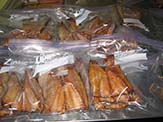Meats and Sausages
Storing Fish
Fish can be eaten immediately after smoking, though many people say that it tastes better when cold. Smoked fish should be wrapped up in wax paper or foil and stored in a refrigerator where it can remain for up to 10 days. To hold it longer, we have to freeze it.
Hot smoked products made from white fish generally keep better than those made from fatty fish, although shelf life will vary considerably depending on the amounts of salt and smoke present, the degree of drying, and the storage temperature. At a chill temperature of about 38 F (3° C) fatty products will keep in good condition for about 6 days and white fish products for about 8 days; at 50° F (10° C) the shelf life is reduced to 2-3 days for fatty fish and 4-5 days for white fish.
Hot smoked products can be frozen and kept at -22° F (-30° C) for at least 6 months and for longer when vacuum packed. Products with a high fat content are inclined to have a soft texture after freezing and thawing. Salted fish should be stored in a cool, dark place, especially if it is fatty. The rate of spoilage in salt fish doubles with each 18° F; salt fish kept at 95° F (35° C) will spoil twice as fast as the fish kept at 80° F (27° C). Keep salt fish at low temperatures where it can remain up to 2 years. The fish can be stored in strong brine at low temperatures, but it must be submerged.
Mark the date when the fish goes into the freezer. Try to freeze fish as fast as possible by making sure they have access to cold air and are not just lying on top of each other. In a day or two, they can be rearranged. The fresh fish develops a firmer structure after smoking. It is best not to freeze fresh fish that will be smoked as its texture changes for the worse. The ice crystals that form during freezing inflict damage to fish tissues, which allows proteins and enzymes to start reacting with meats. Since smoked fish loses moisture during processing, fewer ice crystals form during freezing, and its texture remains firm after thawing. There are differences in temperatures that can be maintained between home and commercial refrigerators and freezers:
| Home Refrigerator | Butcher's Cooler |
| 36-40° F (2-4° C) | 32° F (0° C) |
| Home Freezer | Butcher's Freezer |
| 0° F (-18° C) | -25° F (-32° C) |
During thawing, there is a loss of meat juices, dissolved proteins, vitamins, and minerals, especially when the freezing is slow, which is typical for a home freezer. The resulting red liquid that we see on the plate is not blood; there may be some blood in it, but the main portion constitutes meat juice.
| Product | The maximum recommended times for freezing fish in months | |
| 0° F (-18° C) | -22° F (-30° C) | |
| Fat Fish | 4 | 12 |
| Lean Fish | 8 | 24 |
| Shrimp and Crab | 6 | 15 |
| Clams | 4 | 12 |
Frozen fish loses weight as water evaporates through sublimation. What this means is that the ice which is present in the surface area evaporates without going through the liquid phase. This problem, however, is of more importance for commercial producers as it results in a financial loss. Meat products stored in the freezer start developing an inferior taste due to the oxidation of fat. Those chemical changes known as "rancidity" occur spontaneously and are triggered by light or oxygen. Meats stored in a freezer will turn rancid more slowly than meats stored in a refrigerator. Rancid meat is noticeable more with frozen meat than chilled meat because bacteria can spoil meat in a refrigerator well before rancidity begins. To prevent fat oxidation and to prolong the shelf life of the product, antioxidants such as BHA, BHT, TBHQ, and rosemary extracts are commonly used. In the early days of industrial refrigeration, fish were often frozen in brine. However, it contributed to the faster oxidation of fats. Common vitamin C (ascorbic acid) slows down the rancidity of fats. Adding 0.1% of orange essential oil will provide the same effect.


















